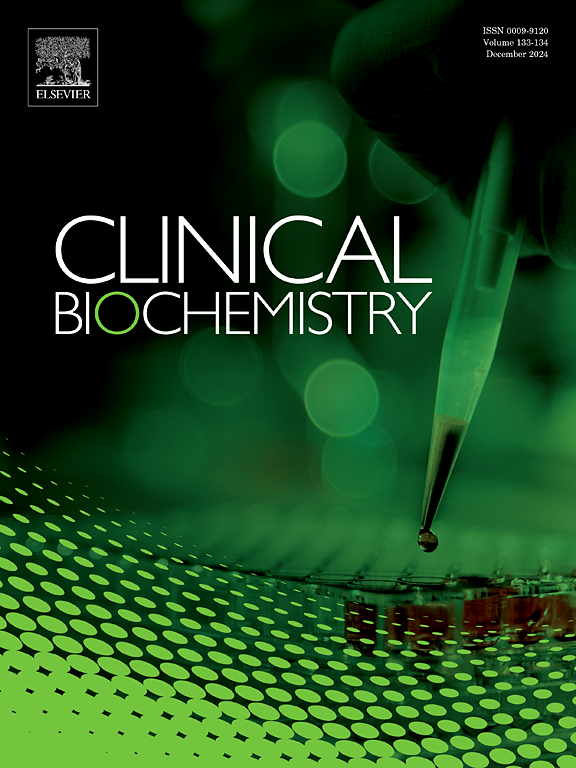定义高灵敏度甲状腺球蛋白免疫测定的临床相关甲状腺球蛋白抗体干扰阈值:单一机构案例研究
IF 2.1
3区 医学
Q2 MEDICAL LABORATORY TECHNOLOGY
引用次数: 0
摘要
分化型甲状腺癌血清甲状腺球蛋白(Tg)水平的解释由于甲状腺球蛋白抗体(TgAb)的干扰而变得复杂,并且没有标准的阈值来确定干扰。随着新仪器的实施,我们观察到增加的TgAb阳性样品,这些样品反射到交替的发送Tg方法,分析灵敏度降低,但对TgAb干扰更强。这导致更少的患者可检测到Tg监测,更长的周转时间和更高的成本。我们假设TgAb检测限(LOD)低于临床有意义的干扰阈值。方法采用电化学发光TgAb免疫分析法(ECLIA-TgAb)≥10 IU/mL对119例血清标本进行分析,比较放射免疫分析法(RIA-TgAb)测定的TgAb与免疫分析法(IMA-Tg)和RIA (RIA-Tg;参比法)测定的Tg水平,并对差异样本进行临床判定。结果ECLIA-TgAb在LOD (10 IU/mL)以上的标本中,30%呈RIA-TgAb阳性。将ECLIA-TgAb阈值提高到20 IU/mL,一致性提高到90%。20 IU/mL的阈值优化了IMA-Tg和RIA-Tg的定性一致性(95%)。患者诊断和治疗的回顾性图表回顾表明,修订后的阈值不会改变患者的管理。我们发现,ECLIA-TgAb阈值为20 IU/mL,可以让更多的患者采用高灵敏度的IMA-Tg方法进行随访,而临床决策没有改变,将发送检测减少了66%。这种方法为个别实验室提供了一种方便和实用的策略,以确定临床上合适的TgAb阈值,以最大限度地提高高灵敏度Tg测量的样品资格。本文章由计算机程序翻译,如有差异,请以英文原文为准。
Defining a clinically relevant thyroglobulin antibody interference threshold for high-sensitivity thyroglobulin immunoassays: a single institution case study
Background
The interpretation of serum thyroglobulin (Tg) levels in differentiated thyroid cancer is complicated by interference from thyroglobulin antibodies (TgAb) and there is no standardized threshold to determine interference. Following implementation of a new instrument, we observed increased TgAb-positive samples which reflex to alternate send-out Tg methods with reduced analytic sensitivity but which are more robust to TgAb interference. This resulted in fewer patients having detectable Tg for monitoring, longer turnaround times, and higher costs. We hypothesized that the TgAb assay limit of detection (LOD) was lower than the clinically meaningful interference threshold.
Methods
We analyzed 119 serum specimens with an electrochemiluminescent TgAb immunoassay (ECLIA-TgAb) ≥ 10 IU/mL, comparing TgAb measurements by radioimmunoassay (RIA-TgAb) and Tg levels measured via immunometric assay (IMA-Tg) and RIA (RIA-Tg; reference method), and clinical adjudication of discrepant samples.
Results
Of ECLIA-TgAb specimens above the LOD (10 IU/mL), 30 % were positive by RIA-TgAb. Increasing the ECLIA-TgAb threshold to 20 IU/mL improved concordance to 90 %. A 20 IU/mL threshold optimized qualitative agreement between IMA-Tg and RIA-Tg (95 %). Retrospective chart review of patient diagnosis and treatment indicated that there would be no change in patient management with the revised threshold.
Conclusions
We found that an ECLIA-TgAb threshold of 20 IU/mL allowed more patients to be followed by the high sensitivity IMA-Tg method with no change to clinical decision-making, reducing send-out testing by 66 %. This approach offers an accessible and practical strategy for individual laboratories to define clinically appropriate TgAb thresholds to maximize the samples eligible for highly sensitive Tg measurement.
求助全文
通过发布文献求助,成功后即可免费获取论文全文。
去求助
来源期刊

Clinical biochemistry
医学-医学实验技术
CiteScore
5.10
自引率
0.00%
发文量
151
审稿时长
25 days
期刊介绍:
Clinical Biochemistry publishes articles relating to clinical chemistry, molecular biology and genetics, therapeutic drug monitoring and toxicology, laboratory immunology and laboratory medicine in general, with the focus on analytical and clinical investigation of laboratory tests in humans used for diagnosis, prognosis, treatment and therapy, and monitoring of disease.
 求助内容:
求助内容: 应助结果提醒方式:
应助结果提醒方式:


